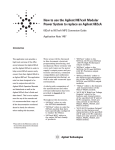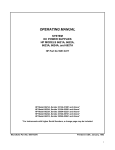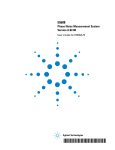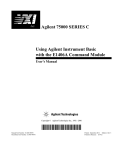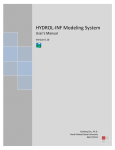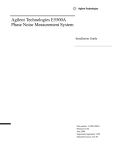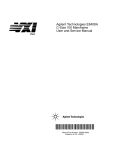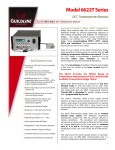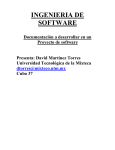Download Electronics Laboratory Practices Based on Virtual Instrumentation
Transcript
Session 12c6 Electronics Laboratory Practices Based on Virtual Instrumentation P. Marino1, J. Nogueira2 and H. Hernandez3 E.T.S. Ingenieros Industriales. Departamento de Tecnologia Electronica Universidad de Vigo, Apdo Oficial 36200 Vigo-Spain 1 Doctor on Telecommunications Engineering, [email protected] 2 Telecommunications Engineer, [email protected] 3 Electronic Engineer, [email protected], [email protected]. Abstract - The authors present an ATE system designed for teaching practices about programmable electronic instrumentation, by means of GPIB and VXI instruments connected to a local area network (LAN). The aim of this system intended for students of electronic engineering, is the introduction of more relevant technologies involved in hardware instrumentation for ATE applications, besides the handling of their software environments for developing programs. LAN [5]. The interface between LAN and GPIB bus is made with the Gateway LAN HP-IB HP E2050 [6]. The VXI bus [2][7][8] is configured in a mainframe for instrument modules in size C cards, and connected to the LAN through the GPIB bus, being its software development tool the environment VEE 4.0 from HP [9][10][11]. The figure 1 shows the ATE system configuration (SIP). Introduction. Teaching electronic instrumentation for engineering students, has a great impact about their basic training on technologies oriented to design systems for: process control, product verification, services operation, quality analysis, etc., over all economic sectors. The growing advance in microelectronics given its continuos reduction in cost and increasing processing power and lower size, with higher performance of software packages, have boosted the presence of powerful systems for automated test equipment (ATE), based on programmable instrumentation [1]. In 90´s decade programmable instrumentation based on GPIB and VXI [2] buses has reached a great spread, allowing ATE systems design with multiple computer platforms and several operating systems, creating the “virtual instrument” concept. Currently the advance impulse for GPIB performances and new architectures for programmable instruments is sustained from manufactures, users and researchers. For example, National Instruments manufacturer introduced respectively the HS488 specification in 1993 oriented to reach a maximum byte rate of 8 MBps in GPIB, and the PXI (PCI eXtensions for Instrumentation) architecture in 1997, based on Compact PCI [3][4], for modular instruments over electronic cards. ATE System Description. In their digital communications laboratory the authors have designed a programmable instrumentation system (SIP) based on IEEE 488 (GPIB) and VXI (VME eXtensions for Instrumentation) buses, where the GPIB bus connects all programmable instruments to laboratory’s PCs by means a Figure 1. ATE system configuration (SIP) of programmable instrumentation laboratory. The Gateway connects the lab’s PC network to the GPIB bus following client/server model [2], where each PC performs as a client and the Gateway as server [6] [12][13]. In this way applications running in clients can communicate with instruments based in GPIB bus in a transparent mode through LAN. This allows several students access to programmable instruments and sharing in this way the SIP resources. The Gateway can be installed in any place of network, depending on instruments location and GPIB's cable length. Instrument identification is reduced to a simple logical address. Table 1 summarizes the features of equipments that conform the SIP: two GPIB rack-and-stack instruments (DC power supply [14] and multimeter [15]), a VXI mainframe [3][7][16] with eight connected instruments ([14][15] and 0-7803-5643-8/99/$10.00 © 1999 IEEE November 10 - 13, 1999 San Juan, Puerto Rico 29th ASEE/IEEE Frontiers in Education Conference 12c6-6 Session 12c6 [17] to [25]), the Gateway, and a PC with WATCH_GPIB software developed by the authors that performs the bus monitor function (paragraph 4). Figure 2 depicts the software/firmware architecture of SIP where each client computer, under operating system Windows 95/NT and with VEE tool, manages the intended programs to control instruments (SICL: Standard Instrument Control Library) and LAN access (TCP/IP). The Gateway has the network server software and adequate firmware for implementing the interface between instruments and LAN. The rack-and-stack GPIB instruments include the firmware with bus drivers. Command module (slot 0 of chassis) from VXI mainframe [17][22] incorporates the needed drivers for VXI/GPIB interface. The PC Bus Monitor only takes the signals from GPIB bus lines for displaying them on the screen (paragraph 4). The VEE (Visual Engineering Environment) tool is a graphic programming language particularly designed for driving programmable instruments. When the instruments are connected to GPIB bus, the student send commands and data following the training program by means of the LAN’s PC. That PC will receive the replay and will perform data analyzing, displaying graphic results or storing data for later processing. Development of Training Program. The growing technological development in the programmable instrumentation field, has allowed to authors the implementation of applied research projects with these kinds of instruments [1], and applications oriented to teaching electronics. In this way one of largely applications of VXI bus has been the automation of measurement and testing over electronic circuits implemented by the students. Simultaneously have been designed practices oriented to evaluation and analysis of GPIB bus activity. The students have access to SIP through PC´s connected to LAN, with the VEE programming tool and SICL libraries (Figure 2), that respectively allow implementing the measurement and testing application and mastering the instruments. Also the students can see the commands and data behavior through GPIB bus by means a PC devoted to this task (Figure 1: Bus Monitor). Figure 2. Software/firmware architecture of SIP. For easing the control of programmable instruments in the development of ATE systems, usually are selected high level programming languages such as C, C++, Visual Basic, and so on. In this application is used the VEE programming language that allows simplifying the task of interface design, data acquisition, processing and displaying of results. Table 2. Comparison between control types of instruments. Table 1. Features of equipments that conform the SIP. There are three control types of instruments in VEE [26][27][28]: Direct I/O, Drivers, and PC Plug-in I/O, which main features are shown in table 2. Laboratory practices have been designed in order to easily introduce the students about the three control types and acquaint them with application needs and available tools. This way is justified since this application does not use the PC Plug-in I/O alternative, given it needs a particular card (VXIplug&play) for implementing the interface, contrary to the cases of Direct I/O and Drivers. Although Direct I/O requires the knowledge of SICL´s instructions, nevertheless it provides high communication speed and does not need the instrument driver, the control type most frequently used in advanced practices. Otherwise VEE gives a new object called Multidevice Direct I/O that gets the control of several instruments through the edition of only one object. The controllers can be the control panel of the instrument (Panel 0-7803-5643-8/99/$10.00 © 1999 IEEE November 10 - 13, 1999 San Juan, Puerto Rico 29th ASEE/IEEE Frontiers in Education Conference 12c6-7 Session 12c6 Driver) or a part of controller (Component Driver). In this application the use of instrument control tools is oriented to teaching, and handling control panels is very important given that students learn to operate the whole choices of each instrument easily. When there is no enough knowledge about SICL´s instructions or choices of an instrument, the Component Driver is the best solution because it provides higher speed and only sends and receives the needed data for implementing a particular task. Also this object has a list of instructions and information for supporting the learning about choices of each instrument. GPIB bus, or displaying stored data in a file (Figure 3). This program loads in the computer memory an interrupt control routine and associates it to parallel port (IRQ7). The line SRQ (Service Request) from GPIB bus [5][8] is used to fire the interrupt routine and read the data from bus. For avoiding the possible loss of data because of GPIB bus higher speed compared with the reading speed of a conventional parallel port, the interrupt routine of WATCH_GPIB program stops temporarily bus activity until reading the suitable data. GPIB Bus Monitor. The programmable instrumentation GPIB bus is a parallel connection bus in which all devices share the line signals [3][5][29], and requires the existence of some equipment for mastering those signals. Figure 4. Flowcharts for implementing and designing laboratory practices. Using the GPIB Bus Monitor the students can visualize the commands and data that is sending through the bus a particular instrument from SIP (Figure 1). Figure 3. Screen of WATCH_GPIB program. Implementation of Practices. The GPIB Bus Monitor (Figure 1) designed for teaching the IEEE 488 instrumentation bus, allows to display in real time, and without lost of information the signal lines that conform the GPIB bus. Given that a device can only access the bus when it is addressed, the GPIB Bus Monitor must not be a bus device since it must read the state continuously, and for this reason it must not have any address, consequently it does not exist from the controller and the whole bus devices point of view. The GPIB Bus Monitor has been implemented by means of a PC under MS-DOS (Table 1). The GPIB interface cards able to connect a PC to the bus do not allow the access to it in a different time to the card has been addressed by the controller, and therefore are not useful for this purpose. For this reason is used an I/O Card adapted for reading the eight data lines and the eight control lines of GPIB bus. The Bus Monitor runs the WATCH_GPIB program that allows gathering and displaying in real-time the available data on The practices are designed in such a way that students can handle the development environment and visualize the GPIB bus. The two first practices are oriented to introduce them the VEE tool and explaining SIP configuration. Both are shown in auto-learning form and introduce step-by-step the method of using the VEE environment, and the control of instruments for making the practices, according the flowchart of figure 4a. Following practices allow students developing their own programs using existing tools, and at any time they can access directly to the SIP for connecting their electronic circuits under test. For example, the practice three is oriented to design a VEE program using the needed instruments for implementing Bode´s diagrams (module and phase) of a RC circuit frequency response. Also shown to the students are the choices used to identify and compare the three control types of instruments (Table 2), and the way VEE objects are 0-7803-5643-8/99/$10.00 © 1999 IEEE November 10 - 13, 1999 San Juan, Puerto Rico 29th ASEE/IEEE Frontiers in Education Conference 12c6-8 Session 12c6 connected following respectively the flow of execution and sequence. Emphasized is the control of instruments (Figure 4b) with the aim that students can identify correctly the working tools. The results of this practice are depicted in figure 5. This interaction with the development environment allows students a better use of the graphic language and the handling of the powerful mathematical functions provided by VEE. Figure 5. Instance of a practice in VEE Other example is practice nine, devoted to the automated testing of electronic boards, in which the students have a board designed for teaching electronic devices, with the aim of designing a graphical interface able to display the results obtained from testing the whole components of board. Basically the control of instruments is made given input signals to the board and, supported by HP E1465A relay matrix switch module [20], implementing the right connection of instruments for making measurements of resistence, AC/DC voltages and currents, period, frequency and polarity test of diodes. The results are shown in figure 6. In each practice is the optional use of the GPIB Bus Monitor, which shows continuously the bus information; sharing this task with the bus monitoring function provided by VEE provides an useful tool when SICL instructions are applied. §Performances of HP-VEE working environment. Results and Future Developments. From the point of view of students the results are: §Accessing to high cost and modern programmable instrumentation equipment. §Training in the use of programmable instrumentation, currently unavoidable in a growing number of enterprises. §Knowledge acquisition about a largely used instrumentation bus. §Use of instrumentation buses like general communication resources if it were needed (i.e.: file transfers between computers). §Displaying an instrumentation bus control signals, besides implementing electronic circuits testing. §Generalization of SIP from general purpose practices to more specific ones such as power electronics, engines control, network analysis, etc. Future developments about new advanced practices and the SIP configuration are: §Using a VXI register-based breadboard module [25] for designing new compatible instruments (i.e.: A/D and D/A converters, sensors and effectors conditioners, etc.). §Implementing automatic evaluation of student throughput during their training time. §Including the new PXI bus for programmable instrumentation (paragraph 1). §Migrating compatible instrument controllers to VXIplug&play standard currently in growing acceptance, and using VISA (Virtual Instrument Software Architecture) libraries [2][3][30]. §Remote training through Internet over the developed SIP. Experiments with Mixteca Technological University (Oaxaca, Mexico) are started. Background Requirements. The set of computer assisted practices designed for teaching programmable instruments to students, requires from them the following previous background: §Circuits theory. §Basic electronic foundations and electronic components. §Experience using manual electronic instrumentation (Oscilloscope, multimeter, function generator, etc.). §Communication protocols for understanding the SIP configuration which have been trained. Figure 6. Interface of automated testing program for electronic boards 0-7803-5643-8/99/$10.00 © 1999 IEEE November 10 - 13, 1999 San Juan, Puerto Rico 29th ASEE/IEEE Frontiers in Education Conference 12c6-9 Session 12c6 Conclusions. The use of communications networks for implementing laboratory practices based on programmable instrumentation, introduces electronic engineering students to designing, configuring, and developing distributed ATE systems. This work introduces a programmable instrumentation system (SIP) development with GPIB and VXI instruments connected to PC´s by means of a LAN. The training program is started with the introduction to knowledge of VEE programming tool, and follows implementing test and measurements over electronic circuits designed by students. Also are added practices for evaluating and analyzing GPIB´s bus signals. Finally basic knowledge required from students are defined in order to obtain the best progress from practices, and are analyzed the obtained results from the point of view of students. Also are introduced the future developments that authors are involved for improving both programmable instrumentation practices and ATE system that runs them. Acknowledgements. This work has been sponsored by R&D NATIONAL SECRETARY AND CICYT from CENTRAL GOVERNMENT (Madrid, Spain) inside of research project, Ref. TIC97-0414. References. [1] Mariño, P. & Domínguez, M. A.: “Image Processing and Automated Testing in Flexible Manufacturing Systems”. Proceedings of the 37th SICE Annual Conference, IEEE98TH 8377, pp. 1121-1126, Chiba (Japan), July 29-31, 1998. [2] HEWLETT PACKARD: Test System and VXI Products Catalog. Hewlett-Packard Company, 1997. [3] NATIONAL INSTRUMENTS: Instrumentation Catalogue: Measurement and Automation. National Instruments, 1998. [4] NATIONAL INSTRUMENTS: PXI Specification Rev.1.0, National Instruments, 1997. [5] Mariño, P.: Enterprise-wide communications: standards, networks and services. RA-MA, Madrid (Spain), 1995. [6] HEWLETT PACKARD: HP E2050 LAN/HP-IB Gateway. Hewlett-Packard Company, 1996. [7] Black, J. (editor): The system engineer’s handbook. Academic Press, 1992. [8] Mandado, E., Mariño, P. & Lago, A.: Electronic Instrumentation. Marcombo, Barcelona (Spain), 1995. [9] HEWLETT PACKARD: Building an Operator Interface with HP VEE. Hewlett-Packard Company, 1995. [10] HEWLETT PACKARD: Exploring HP VEE. HewlettPackard Company, 1995. [11] HEWLETT PACKARD: How to Use HP VEE. Hewlett-Packard Company, 1995. [12] HEWLETT PACKARD: Installing the HP-IB Interface. Hewlett-Packard Company, 1994. [13] HEWLETT PACKARD: HP 82335, 82340 & 82341HP-IB Interface. Hewlett-Packard Company, 1996. [14] HEWLETT PACKARD: Operating Manual, System DC Power supplies, HP models 6621A, 6622A, 6623A, 6624A and5527A. Hewlett-Packard Company, 1993. [15] HEWLETT PACKARD: HP 3478A Multimeter: Operator’s Manual. Hewlett-Packard Company, 1988. [16] TEKTRONIX: VXIbus System Specifications Revision 1.4. Tektronix Inc., May 1992 [17] HEWLETT PACKARD: High-Power Mainframe HP E1401A: User’s/Service Manual. Hewlett-Packard Company, 1992. [18] HEWLETT PACKARD: HP E1410A 6 ½ Digit Multimeter: User’s Manual. Hewlett-Packard Company, 1992. [19] HEWLETT PACKARD: HP E1445A Arbitrary Function Generator. Hewlett-Packard Company, 1992. [20] HEWLETT PACKARD: 16x16, 4x64, and 8x32 Relay Matrix Switch Modules HP E1465A/E1466A/E1467A: User’s [21] HEWLETT PACKARD: C-Size VXIbus Systems: Configuration Guide. Hewlett-Packard Company, 1994. [22] HEWLETT PACKARD: Command Module HP E1406A: User’s Manual. Hewlett-Packard Company, 1994. [23] HEWLETT PACKARD: Universal Counter HP E1420B: User’s Manual. Hewlett-Packard Company, 1994. [24] HEWLETT PACKARD: Digitizing Oscilloscope HP E1428A: User’s Manual. Hewlett-Packard Company, 1994. [25] HEWLETT PACKARD: HP E1490C C-Size VXIbus Register-Based Breadboard Module: User’s Manual. HewlettPackard Company, 1996. [26] HEWLETT PACKARD: HP I/O Libraries. HewlettPackard Company, 1996. [27] HEWLETT PACKARD: Controlling Instruments with HP VEE. Hewlett-Packard Company, 1998. [28] HEWLETT PACKARD: Getting Started with HP VEE. Hewlett-Packard Company, 1998. [29] Caristy, J.: IEEE 488 General Purpose Instrumentación Bus Manual. Academic Press, 1989. [30] Helsel R.: Visual programming with HP VEE. HewlettPackard Professional Books, third edition 1998. manual. Hewlett-Packard Company, 1993. 0-7803-5643-8/99/$10.00 © 1999 IEEE November 10 - 13, 1999 San Juan, Puerto Rico 29th ASEE/IEEE Frontiers in Education Conference 12c6-10









